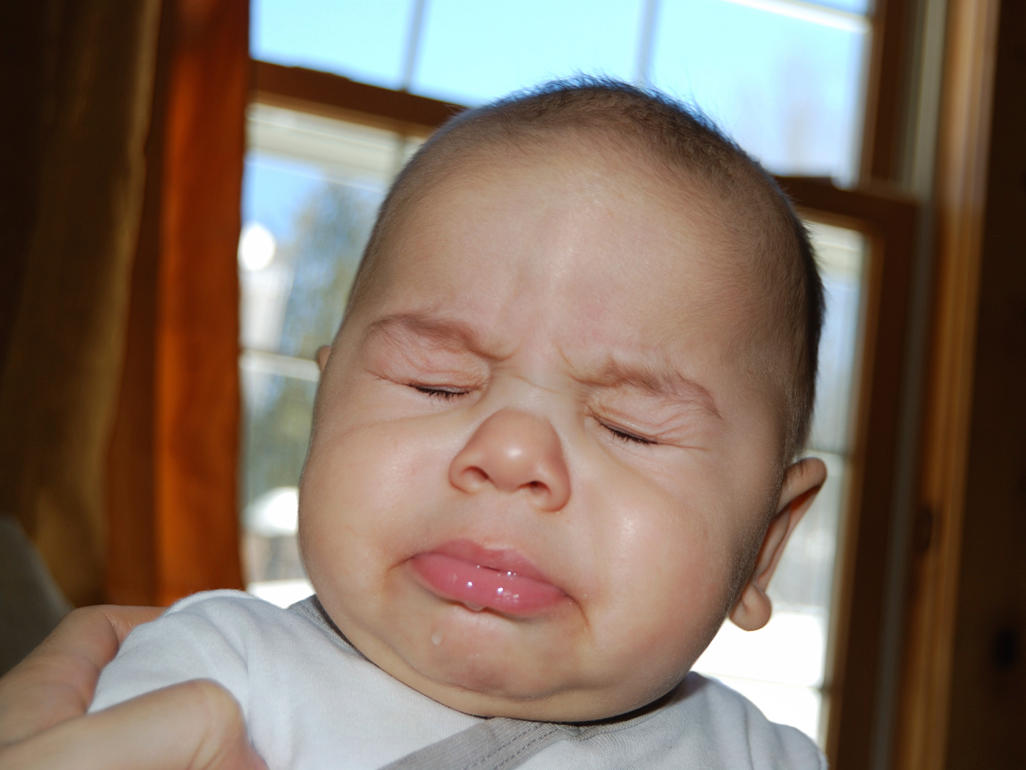Flu In Babies

Contents:
- The Causes Of The Disease
- Symptoms Flu In Babies
- Complications Flu In Children
- Diagnosis Of Flu
- Treatment Flu In Babies
- Prevention Flu In Babies
The flu belongs to the group of acute respiratory diseases (ARD) and is one of the most dangerous diseases among them. The infection may affect people of any age, however children are the most vulnerable. The immune system of the baby is not fully formed, that’s why babies are at risk for serious complications if they get the flu.
The Causes Of The Disease
Influenza or the flu is an acute infectious respiratory disease caused by a virus in the orthomyxovirus family. There are several types of flu:
- type A;
- type B;
- type C.
The most dangerous in epidemiological terms is the first type of the flu virus. Its surface features two proteins-antigen: hemagglutinin (H) and neuraminidase (N). Hemagglutinin attaches the virus to target cells, while neuraminidase destroys cells’ shells, and the virus is able to enter the body. It is believed that intoxication is defined through the hemagglutinin activity, while neuraminidase contributes to the oppression of the immune system.
Each of the antigens has its subtypes. There are 12 subtypes of hemagglutinin, designated as H1, H2, H3, etc., as well as 9 subtypes of neuraminidase antigens – N1, N2, N3 and so on. Their combination gives the name of a virus type. H1N1 is a so called swine flu, H5N1 is a bird flu. In general, the clinical picture of influenza caused by different types of the virus is practically the same. Swine flu in children is a typical flu infection. In the article Flu: symptoms, treatment, complications and prevention you can read about the most common flu types to spread in the northern hemisphere in 2015-2016.
Symptoms Flu In Babies

The flu spreads by droplets. A person with the flu transmits the virus by sneezing and coughing. Thus, a person located within two-three meters can get infected. The virus attaches to the epithelium of the nasal mucosa, the larynx. Then it enters the blood and travels across the body. The incubation period is short: from a few hours to three days. On average, it doesn’t last longer than one or two days. There are four forms of flu:
- mild;
- moderate;
- severe;
- hypertoxic.
Flu Symptoms Of Moderate Severity
Using a clinical picture of the disease it might be quite difficult to identify what kind of infection the baby has: a flu or another ARD. Indeed, ARD infections have very similar symptoms. However, the flu (swine or any other) is characterized by a sudden onset of the illness. Just few hours ago the child was active and cheerful, and now has become sluggish and looks unhealthy. The onset of the disease is often accompanied by a temperature rise up to 38-40 С (100-104 F), fever persist for two or three days. The child complains of pressing eye pain, headaches, body pain.
A sick kid becomes restless, whiny. On the second day the child may complain of a sore throat, dry cough. He may experience nasal congestion due to the swelling of the mucous, have scarce clear discharge from the nose. Profuse nasal discharge is atypical for the flu virus; this might be a symptom of a rhinovirus. Among other symptoms are cardiovascular problems such as blood pressure fluctuations, and increase in the heart rate.
Pains in the abdomen, as well as vomiting, diarrhea are common symptoms of the swine flu in babies. Influenza virus provokes vessels’ fractures, so the baby may have punctate hemorrhages as well as nosebleeding. The condition of the child is gradually improving when the temperature drops. However, he may still have wet cough for four-seven days more. Within a month after the illness, the baby might be less active and feel rapid fatigability. At this time you should limit the child’s physical activity.
Flu Symptoms Of Severe Severity
The clinical picture of the disease includes intoxication symptoms. The high temperature may cause delirium, hallucinations, hemorrhagic phenomena (nosebleeding, bleeding gum and subcutaneous hemorrhages). The temperature reaches 39-40 C (102-104 F) and holds up for a long period of time. Younger babies develop neurotoxemia that is manifestated in:
- headache;
- nausea, vomiting;
- meningism symptoms;
- convulsions.
The severe flu form is often followed by various complications, such as hemorrhagic pulmonary edema. The most dangerous for children is hypertoxic form of influenza, which is characterized by extremely severe and rapid advances contributing to such a terrible condition, as infectious-toxic shock. Quite often this form of the disease isn’t followed by catarrhal symptoms such as a stuffy nose and cough. The hypertoxic form of influenza can cause death due to pulmonary edema or acute cardiovascular insufficiency. The death can occur after just a few hours after the appearance of the first symptoms.
Complications Flu In Children

Complications of flu can be divided into two groups:
- Primary — caused by the influenza virus;
- Secondary — caused by a secondary infection.
Primary Complications
The most terrible complication of this group is hemorrhagic pulmonary edema that occurs in the first days of illness and can cause death. The pronounced toxemia is followed by shortness of breath, blood-tinged sputum, blue skin, increased heart rate. Severe respiratory insufficiency may cause death. Children may also have false croup caused by swelling of the vocal cords and spasm of the larynx’ muscles. This condition is characterized by the nighttime asthma attacks. Such attacks are usually accompanied by increase in the heart rate and feeling of anxiety. Progression of the larynx swelling does not let air enter the lungs and the baby starts to suffocate. Flu virus has a particularly negative impact on the nervous system. Possible complications:
- arachnoiditis;
- swelling and impaction of the brain in the foramen magnum;
- brain hemorrhage resulting in paralysis;
- Guillain-Barre syndrome;
- neuralgia, polyneuritis;
- Reye’s syndrome.
Note: Reye’s syndrome develops when influenza is treated with aspirin. You should avoid this medication. This syndrome is characterized by severe brain and liver damages. Glomerulonephritis is another complication that may develop within one-two months after the illness. The disease is manifested by reduced urination, swelling, increased blood pressure. The heart may also develop complications in the form of myocarditis or endocarditis.
Secondary Complications
In most cases the flu ends with full recovery of the child. Complication pose more risk than flu itself. Secondary complications arise when influenza is joined by a secondary infection (usually bacterial), or activates any chronic infections. The most common and dangerous complication of influenza is bacterial pneumonia. This condition is characterized by fever of 38 C (100 F) or above on the fifth day of illness, severe weakness, wet cough with purulent sputum. While coughing the child presses the chest with hands, because this area of the body is aching. Another category of secondary complications are illnesses of ORT organs. The most common among them are the following:
- otitis;
- sinusitis;
- pharyngitis.
Diagnosis Of Flu

The pediatrician is sure to take a blood test from the baby with similar symptoms. What changes will the test show?
- reduction in the number of leukocytes;
- acceleration of ESR;
- reduction in the number of neutrophils;
- reduction in the number of lymphocytes.
However, this method is not specific. The changes described above testifies to the presence of a viral infection, but do not provide information about its pathogen. Specific diagnosis makes it possible to identify the flu virus. The patient is taken nasal smears that are put on a glass slide. The resulting product is treated with a fluorescent dye and then examined under a luminescent microscope.
This method became known as fluorescent antibody method. PCR method is also used to diagnosis the flu, which allows determining the virus’ RNA in nasal smears. Thanks to modern methods of diagnostics the diagnosis may be obtained the same day as the smear was taken.
Treatment Flu In Babiesh
Uncomplicated influenza does not require active measures. The child should only have bed rest. Treatment of influenza at home should be carried out in compliance with sanitary recommendations. You should airate the child’s room several times a day and conduct wet cleaning. During illness children usually loose appetite. Don’t make your child eat if he is unwilling. Select light dishes, such as low-fat chicken soup, eggs, dairy products.
The most important rule is to drink plenty of fluids. This may be natural fruit drinks, juices, compotes. Such drinks not only contribute to the removal of the virus, but also nourish the child’s organism with vitamins and microelements. To manage other symptoms you can use antipyretic medications, nasal sprays, cough lozenges, rarely expectorants. Let’s discuss in detail the use of antipyretic medications. Children can take only two drugs from a wide range of NSAIDs, namely ibuprofen and paracetamol.
It is known that fever is a protective reaction of the organism. In this way the body fights an infection, so it is not recommended to break the temperature of 38 C (100 F) and above. However, in certain situations it is a necessary measure. Antipyretic drugs should be administered if:
- temperature is above 39 C (102 F) degrees;
- temperatures above 38 degrees, if a child has a history of convulsions;
- temperature of over 38.5 degrees if the child has any chronic diseases;
- temperature is above 38 degrees in newborn babies.
Influenza infection is the only disease in ARD group that can be treated etiotropically. Anti-influenza drugs can be divided into two groups:
- M2 receptor inhibitors— remantadin;
- Neuraminidase inhibitors— tamiflu, zanamivir.
These drugs can be administered only in hospital environment under the supervision of a physician. It’s a very important condition, because despite their effectivity, they have serious side effects. These medications should be taken during the first day of illness.
Note: Use folk medication with great precaution. Some of them would be simply ineffective, while others can pose risk to the baby’s life. Don’t rub your child with spirit and wrap him in warm blankets. These manipulations can lead to overheat and harm thermoregulatory mechanisms. Unfortunately, doctors often face such situations, when a child dies because of such seemingly innocuous manipulation.
Prevention Flu In Babies
Preventive measures can be divided into specific and nonspecific. Non-specific prevention of influenza in children includes adequate nutrition and sleep, walking in the fresh air, moderate exercise, avoidance of large gatherings of people. Specific prevention is vaccination. Vaccines can be:
- inactivated;
- live.
Doctors recommend not to neglect vaccination because flu in children often acquires a severe form, and it’s better to avoid it than to treat. Usually vaccinations are made before the flu season in September or in early October. However, if the child hadn’t been vaccinated in the mentioned period, he get vaccinated even during the epidemy. The most important thing – the child should be healthy to get vaccinated. If the baby has a running nose and cough he can’t get vaccinated.
Video: What are Flu Symptoms?